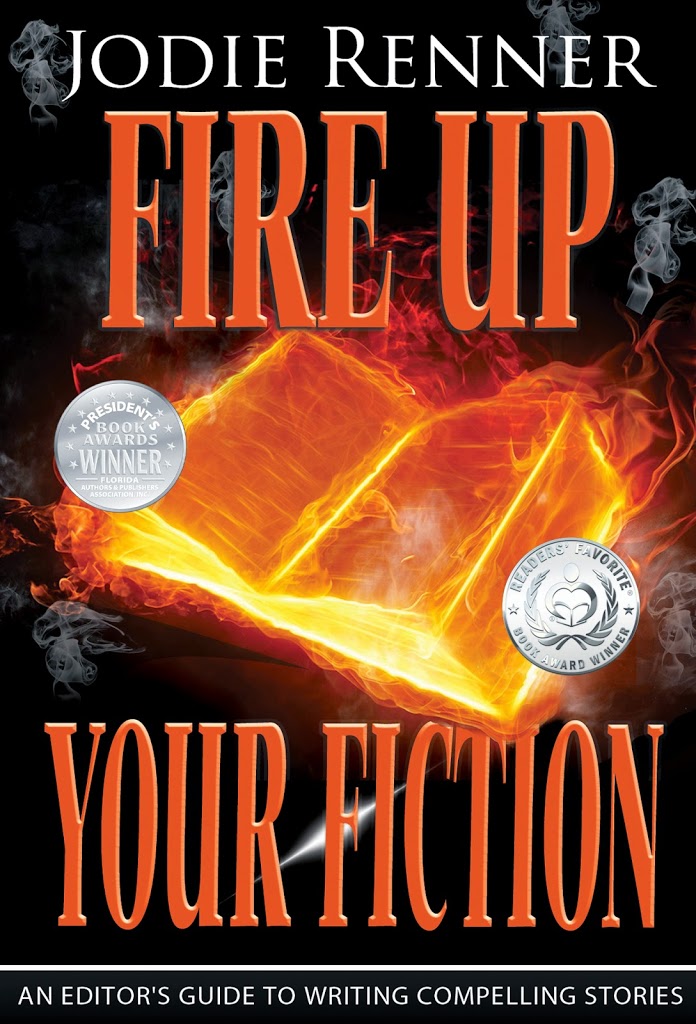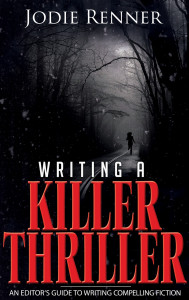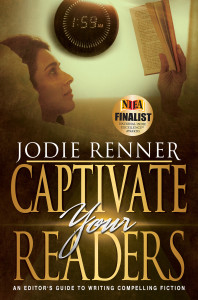 by Jodie Renner, editor, author, speaker @JodieRennerEd
by Jodie Renner, editor, author, speaker @JodieRennerEd
In POV 101 – Get into your protagonist’s head and stay there, I discussed the effectiveness of starting out your story in your protagonist’s point of view and staying there for most of the novel.
But what if you want to show how other people are feeling? If they’re important characters, like the villain, a romantic interest, or a close friend or family member, you can give them their own POV scenes, where you get into their heads and we see their thoughts, emotions, goals, aspirations and fears.
If they’re in the same scene as your main character, you show their thoughts, feelings and attitude only through what your protagonist can perceive—their words, tone of voice, body language and facial expressions. Say you’re writing a romantic suspense or mystery, and you’re in the heroine’s point of view, showing her thoughts, perceptions and reactions. The hero, whom she’s just met under unfortunate circumstances, is angry. You’ll show his thoughts and reactions, not from inside him at that point (What the hell is going on here? he thought. What’s she trying to pull off, anyway?), but by what the heroine is seeing and hearing—his tense posture, hunched shoulders, clenched fists, furrowed brows, set mouth, clipped tone of voice, angry words, etc.
The general rule of thumb is “one scene, one viewpoint.” Or even better, wait for a new chapter to change the point of view to someone else’s. If you change the viewpoint within a scene, it’s best to do it only once, and leave a blank space before you start the next person’s point of view. Ping-ponging back and forth can be jarring and confusing to the reader. This is what’s referred to as “head-hopping.” Some writers go so far as to leave three asterisks (* * *) and spaces above and below to indicate a switch in viewpoint within a scene, but I think that’s too jarring and disruptive to the flow of action, since we’re still in the same scene. Three asterisks, centered, are best reserved to indicate a shift in place and time.
So why is it so important to avoid switching viewpoints (head-hopping) within scenes?
 According to Cynthia VanRooy, “When a reader becomes emotionally engaged in a book, he or she enters into the story. The reader understands the book world isn’t real, but in order to fully enjoy the story, he or she chooses to temporarily pretend otherwise, or to suspend their disbelief. […]
According to Cynthia VanRooy, “When a reader becomes emotionally engaged in a book, he or she enters into the story. The reader understands the book world isn’t real, but in order to fully enjoy the story, he or she chooses to temporarily pretend otherwise, or to suspend their disbelief. […]
“Every time you shift the reader from one character to another, they are jarred out of their suspension of disbelief and reminded that they’re only reading a story. Do that often enough and they’ll stop reading your story. Scene changes or new chapters are the best and least disruptive places to change POV.”
Here’s an example of a viewpoint gaffe, which I made up:
Our heroine, Carole, is stirring the spaghetti sauce on the stove and talking to her husband on the phone. They’re discussing the fact that their son, Colton, is grounded. Suddenly, the author jumps into her son’s head and tells us about Colton sneaking by behind her back (his rap music is playing loudly in his room), and out the front door, then jumping on his bike and racing off. Back to Carole, who continues to stir the spaghetti and talk on the phone.
What’s wrong here? We were in Carole’s POV, and she had her back turned so she wouldn’t know Colton was sneaking past, especially with all that noise coming from his room. And how would she know he’s riding away on his bike? Another jarring POV shift in the same scene would be if we suddenly started seeing her husband waving his secretary away because he’s in an important conversation. We’re in Carole’s POV in this scene, and she can’t see what her husband is doing at his office.
Here’s another example of ping-ponging point of view, where we the readers jump back and forth over miles, within seconds.
We start out in Steve’s point of view, who’s in trouble and has just picked up the phone and called his wife, Grace:
“Grace, thank god you’re home. This is all too much for me. My life is crumbling around me and I can’t seem to do anything about it,” Steve said, closing his eyes and rubbing his face.
The sadness and despair in his voice brought tears to Grace’s eyes.
“I have to think.” There was long pause before Steve continued. “Luckily, George is right here. I’ll ask if he knows a good attorney who can help with this.”
“That sounds good.” She felt some relief.
“I’ll call you later,” Steve said, then hung up and slumped back in his chair.
“I’ll be waiting,” she said softly. The call ended before she could say I love you.
What’s wrong with how this scene is written?
Choose either Steve or Grace and play the scene from his or her POV. Show us only what he or she can see, hear, and perceive.
A quick way to check whose POV you’re in is to get out the highlighters or colored pens and choose a different color for each of your main characters. Pick your protagonist’s color, then start highlighting or underlining sentences that describe scenes, people, perceptions, and emotions strictly from his or her POV. Do the same for other characters, with their color. When you’re done, you should have paragraphs, and preferably scenes, of only one color. If you have another color creeping into that scene, see if you can rewrite those sentences from the dominating character’s POV. If you have a number of colors within one scene, you’ve got some revisions to do. And as Stephen King says, “Writing is rewriting.”
 By the way, my third book, Captivate Your Readers, gets into a lot of detail on engaging your readers and bringing your story and characters to life by using deep point of view, showing instead of telling, and stepping back as the author to let the characters tell the story in their own voice.
By the way, my third book, Captivate Your Readers, gets into a lot of detail on engaging your readers and bringing your story and characters to life by using deep point of view, showing instead of telling, and stepping back as the author to let the characters tell the story in their own voice.
Also, check out POV 103 – Engage Your Readers with Deep Point of View here on TKZ. And check out the handout to my workshop “Engage the Readers with Deep Point of View” on my own blog.
Jodie Renner is a freelance fiction editor and the award-winning author of three craft-of-writing guides in her series An Editor’s Guide to Writing Compelling Fiction: Captivate Your Readers, Fire up Your Fiction, and Writing a Killer Thriller. She has also published two clickable time-saving e-resources to date: Quick Clicks: Spelling List and Quick Clicks: Word Usage. You can find Jodie at www.JodieRenner.com, www.JodieRennerEditing.com, her blog, http://jodierennerediting.blogspot.com/, and on Facebook, Twitter, and Google+.

I am deep in formatting my book for print, so I pulled out a stack of hardbacks to liberally sample their formatting tricks.
In 61 Hours, one of the legion of Jack Reacher novels, when they change scenes/POV, the first three words of the first paragraph are in the same font as the chapter heading and bolded (like the first line of each chapter.) It is an elegant little device.
My editor caught a couple of spots where I close, but I never stepped all the way over the line.
Essential truth #1: Larry McMurtry can get away with it. Essential truth #2: I’m not Larry McMurtry (and that’s okay.)
Signed Devil’s-Deal-Coming-Soon (the writer formally known as Terri)
Yes, Nora Roberts can get away with it, too, Terri, but she’s one of the few who can! And I’d still prefer she not do it, as it doesn’t really work for me. More in POV 103.
Congratulations on getting Devil’s Deal edited and almost out there, Terri! Can’t wait to read it! 🙂
This is a timely discussion for me. We were discussing POV in my critique group, and a writer was struggling to understand why certain phrases she used had the effect of “head hopping.” As in, ” Her mood blackened.” That sentence takes us into that character’s head a little bit. If the POV belongs to another character, it would be better to say something like, “Her expression darkened.” That conveys something that is observed by the POV character, without straying inside the other person’s head.
Yes, I would definitely flag that as a point-of-view shift, Kathryn. And I like your suggestion – perfect. After POV 103, (in what I guess I’ll call POV 104), I’m going to present a bunch of short examples and have TKZers tell us what’s wrong and how to fix it. Participants in my workshops always find that fun!
Maybe I’m just strange,but I’ve never really had a problem with POV or head hopping. I mess up on very rare occassions, but for the most part I’m good at staying in one POV.
I will say though, I tend to use more than just the main characters’ POV throughout a book. My first book has four main character POVs and I think one minor character POV throughout the book. But my beta readers have told me they like that a lot since they get to know each character personally. And my beta readers are harsh.
I suppose it’s different for every reader.
This comment has been removed by the author.
(I had a typo in my above comment so I deleted it.)
Hi R.A., a lot of novels use two or three, maybe four points of view. But give each POV character their own scene or chapter. Also, I think it’s important to have one MAIN main character, someone through whose eyes we see most of the story. That way it’s easier for readers to bond with him/her and get more emotionally engaged in the story and their plight. So if your story has four main characters (which I personally, as a reader, am not crazy about), give one of them more POV scenes and chapters – the one who’s most sympathetic and complex, and who has the most at stake in the story.
But as you say, it’s different for every reader.
Just to clarify my above comment – I meant I’m not crazy about having four equally important main characters – I think it’s better to let the readers identify and bond with one main character. But having 7 or 8 or maybe even more POV characters throughout a novel can work if what they’re thinking/scheming is critical to the plot, and as long as you get back to the main character in between the others, to keep him/her uppermost in our minds and remind us of who we’re rooting for. Don’t spread yourself too thin or the readers will become less engaged, less invested in the plight of the main character.
Thanks for your comments, Jodie. You really didn’t have to delete the one with a typo! We all make them. XD
I have four major characters, but the majority of the book is between two, and one really gets more attention than the other. Also, I generally don’t change POV unless I’m starting a new chapter. Thanks for the advice though. =)
Sounds good to me, R.A.! I look forward to reading your novel! 🙂
In my romances, I use a space break when I switch viewpoints between hero and heroine. I agree with your tips. Newbies tend to head hop. I know it took me quite a while to understand the concept of POV when I was starting out.
Good to hear a seasoned writer like you agrees with my tips, Nancy! And yes, this seems to be one of the most difficult concepts to master for many of my fiction-writing clients.
A tool that I recently saw, and have employed in my current WIP, to keep me in mind of who’s head I am in is to label each chapter with the character from whose perspective that chapter is seen and stick to it. That is, instead of a chapter heading like:
1
Glenn Highway
Eagle River Alaska
1600 hrs
The heading became
1
Brad
A chapter which will have a lot of action and only a few paragraphs from each POV will have a heading like:
14
Farmhouse
And then each few paragraph scene showing the perspective, and a bit of white space before the next short scene from a different POV.
It started off as a tool for myself, after one of my well-established Beta-Readers pointed out the head hopping. But after doing that in each chapter of the first book of the series decided to leave it there. Waiting to see what the agent says on that one, but as I work on book two I am doing the same thing to help keep the perspective locked in every scene.
Good idea, Basil. But if I were editing such a novel, I’d probably advise my client to cut down on the number of different POVs within one chapter to two or a maximum of three. And if a character’s POV scene only lasts one paragraph, I’d advise the author to rework it. Otherwise, it still seems like head-hopping to me.
It’s best to keep to the POV of the main character for most of the novel, like about 70% or more, and only go into the POV of other characters who are important, like the villain or other antagonist or the love interest or sidekick.
If it’s a minor character or for just a short time, you don’t need to switch the POV – you can show how the other character is feeling by his words, actions, facial expressions, body language, and tone of voice.
Basil, for more on how I see POV being most effective for the readers, check out my second comment to R.A. above.
It’s funny, I never used to notice head hopping until I really began to study the mechanics of writing. Now it stands out to me so clearly. I recently read a novel by a famous author, and was surprised by two incidents of head hopping! No one is perfect :/
Yes, I notice it in a few (very few) well-known authors, too, Julie, and it bugs me. I want to know early on which character I’m supposed to be rooting for, not be bounced back and forth among characters. Thanks for sharing this on post on Twitter! 🙂
Thanks for the great post, Jodie. Now it’s time to revise, revise, revise. 🙂
Glad you found my observations helpful, Della! 🙂
Thank you for this EXCELLENT post. I do wish more writers would read it. I simply can’t read a book where the author head-hops. It’s maddening. Nonetheless many best selling authors do it. (Michael Chriton, John Grisham). UGH! Recently I read a book by a fellow writer (self-pub). I marked every instance in which he jumped from POV. Also, I read the Dressmaker by Kate Alcott–again, I marked all the POV errors.
My question is why can’t writers get it? It’s not that hard.
I agree, Joan. I started a book by John Grisham recently but I got so frustrated by all the head-hopping on the first two pages that I put it down and haven’t picked it up since.